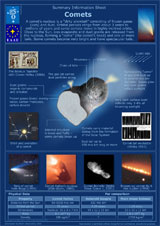|
Residing at the farthest reaches of the Sun's influence, comets did not undergo the same heating as the rest of the objects in the solar system, so they retain, largely unchanged, the original composition of solar system materials. As the preserved building blocks of the outer solar system, comets offer clues to the chemical mixture from which the planets formed some 4.6 billion years ago. The geologic record of the planets shows that, about 3.9 billion years ago, a period of heavy cometary and asteroidal bombardment tapered off. The earliest evidence of life on Earth dates from just after the end of this heavy bombardment. The constant barrage of debris had vaporized any water on Earth, leaving the planet too hot for the survival of the fragile carbon-based molecules upon which life is based. Scientists therefore wonder: How could life form so quickly when there was so little liquid water or carbon-based molecules on Earth's surface? The answer may be that comets, which are abundant in both water and carbon-based molecules, delivered essential ingredients for life to begin. Comets are also at least partially responsible for the replenishment of Earth's ocean after the vaporization of an early ocean during the late heavy bombardment. While Earth has long been regarded as the "water planet," it and the other terrestrial planets (Mercury, Venus and Mars) are actually poor in the percentage of water and in carbonbased molecules they contain when compared to objects that reside in the outer solar system at Jupiter's orbit or beyond. Comets are about 50 percent water by weight and about 10 to 20 percent carbon by weight. It has long been suspected that what little carbon and water there is on Earth was delivered here by objects such as comets that came from a more water-rich part of the solar system. While comets are a likely source for life's building blocks, they have also played a devastating role in altering life on our planet. A comet or asteroid is credited as the likely source of the impact that changed Earth's climate, wiped out the dinosaurs and gave rise to the age of mammals 65 million years ago. Read more about comets in general. This text is extracted from the NASA Deep Impact Launch Press Kit. More information on the Deep Impact mission is available on the project home page. |
|
For more historical background on comets, please have a look at the History of Comet page.

